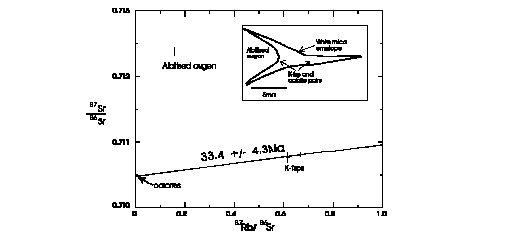K-feldspar/plagioclase and feldspar/white mica isochrons for Alpine basement gneisses from the Sonnblick Dome and the Monte Rosa Massif.

White mica/feldspar mineral separates from basement gneisses often give ages which appear to be unrelated to a specific event. Such results may be due to the presence of more than one generation of white mica or inaccurate estimation of initial 87Sr/86Sr. In granitic basement rocks feldspars are the major Sr reservoirs; any variation in isotopic composition within or between grains may result in biased estimates of initial Sr isotopic compositions during deformation/recrystallisation. This clearly presents problems in using conventional mineral separate analysis to date deformation in poly-metamorphic rocks. However, using optical/electron microscopy it is possible to identify domains which appear to have equilibrated chemically/texturally. Such areas are likely to have achieved Sr isotope equilibration during deformation/metamorphism. For example many minerals which crystallise in augen tails or the hinges of crenulations during deformation clearly appear to be in textural equilibrium. Refined techniques have enabled microdrilled samples 100-300mm in diameter to be extracted from a thin section and the isotopic composition analysed to within ± 0.00004.
Microsampling has enabled various co-existing mineral pairs to be analysed for Sr isotopes. Deformation in a Sonnblick Dome (Tauern Window) augen gneiss has been dated directly by sampling co-existing K-feldspar and calcite in the recrystallised tail of an albitised augen. Figure 1 illustrates that K-feldspar and calcite crystallised at 33.4 ±4.3Ma. Despite the high error on this measurement due to the similarity in Rb/Sr it is clear that the albite augen has failed to equilibrate with the same Sr reservoir during Tertiary metamorphism. Over 80% of the Sr in this sample is retained in albite augen making it impossible to obtain accurate initial 87Sr/86Sr ratios for this deformation using mineral separate analysis of feldspar. Similar techniques have been applied to obtain reliable ages from fabric defining white micas and co-existing feldspars. Data will be presented using
K-feldspar/plagioclase and feldspar/white mica isochrons for Alpine basement gneisses from the Sonnblick Dome and the Monte Rosa Massif.
Fig. 1: Rb/Sr isochron for 2 calcite/K-feldspar pairs. The ratios of an albitised augen are also plotted. Inset shows sketch of thin section with sampling localities.